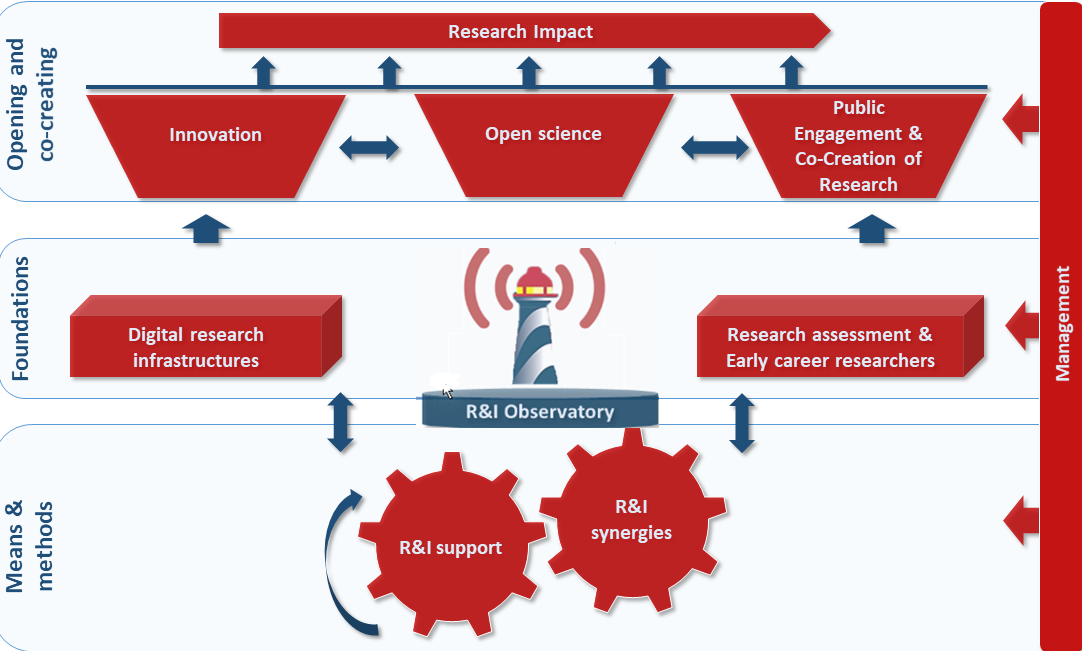ENLIGHT Outputs
Interested in the ENLIGHT R&I outputs and results? Below you may find relevant information per major area of activity.
Interested in the ENLIGHT R&I outputs and results? Below you may find relevant information per major area of activity.


The report explores and applies a technology intelligence-based approach to map the R&I activities of the nine universities of the ENLIGHT Alliance based on a set of selected scientific and technological data associated with them.
The report brings together a mapping of Digital Research Infrastructural Resources across ENLIGHT RISE partners. A mapping exercise aims at creating an overview of platforms, competencies and priorities within the ENLIGHT community. The objective is to identify synergies related to the ENLIGHT flagship areas and provide input for future joint R/I actions. A roadmap for connecting and sharing digital infrastructural resources between the nine partner universities is outlined. Preparations for future digital alignment of innovation ecosystems and a responsible use of AI are also discussed.
The report brings together initiatives, tools and methods in the DI/AI Digital Ecosystem of the ENLIGHT Alliance in order to identify possibilities related to the ENLIGHT R&I Agenda.
This report will describe how ENLIGHT can actively contribute to advancing responsible DI/AI R&I, to optimize its impact on the 5 flagship challenges and develop a responsible DI/AI Development Index to assess and monitor the implementation of these guidelines.
ENLIGHT RISE partners explore how the current debate impacts the evaluation systems of individual universities and what it might mean for the ENLIGHT European University. This background document is a starting point for all those involved in the assessment of research and researchers - policy makers, research support staff and researchers involved in the design and implementation of research(er) assessment systems – to plunge into the current debate and its implications.
An overview of the ongoing debate on the reform of research and researcher assessment is complemented by case studies from the ENLIGHT partner universities. These case studies highlight innovative responsible assessment practices that contribute to reshaping the research and researcher assessment landscape, with the potential to culminate in a transformative shift in the evaluation culture within academia.
The report brings together a mapping of the academy-industry partnerships. The objective is to identify synergies related to the UN-SDGs & ENLIGHT flagship challenges.
The report identifies gaps and opportunities in the market for skills and innovation, which match with common, synergistic Research and Innovation skills across the alliance.
This report brings together a mapping of existing initiatives supporting industry-academy collaborations and entrepreneurship in ENLIGHT universities.
Mapping of Open Science (OS) activities across the ENLIGHT university alliance through an Open Science Status Matrix. It highlights good practices, identifies gaps and opportunities for joint action, proposes joint principles, and outlines options for rewards and incentives.
The Enlight Open Science, Open Access (OA) and Research Data Management (RDM) Starter Kit will bring together basics arguments and information on how to get started, generic information and information on OA and RDM – where to get started, where are places to get information for example on GDPR, DMPs, data repositories, required policies, licenses etc. Usable templates which can be adapted to local situation and different subject fields.
This report describes the developments of Open Science (OS) in ENLIGHT between 2022 and 2024 and provides an update of the information collected and presented in D7.1 ENLIGHT Open Science Status Quo & Opportunities. It targets the question of whether and to what extent the previously determined OS status quo has changed. It highlights ongoing approaches, support and services and good practices, describes joint actions, introduces the joint OS principles and outlines activities related to the OS ambassadors and the OS award.
What is the relation between Open Science and Software Licenses? What is the difference between Free Software and Open Source? Which process should I follow to share my software? In this presentation, we will demystify various software licenses, ranging from permissive ones like MIT and Apache to copyleft licenses such as the GNU General Public License (GPL). We will demonstrate how the choice of a particular license can influence the accessibility, distribution, and reuse of scientific software, highlighting the pivotal connection between open-source licensing and the principles of Open Science.
Open Science aims at a cultural change in how research is conducted and shared. Transparency, reproducibility and openness are core features that enhance the quality and impact of research by fostering collaboration and engagement with research processes and outputs.These changes should be taken into account when researchers are evaluated. We will examine current frameworks and approaches on how responsible research assessment can recognise and reward open research, and how in turn Open Science can improve and complement research assessment processes themselves.
On 23 November 2023 the ten ENLIGHT Rectors endorsed joint Open Science principles on the occasion of the ENLIGHT General Meeting in Uppsala. With the joint statement ENLIGHT aims to create a common basis for an Open Science culture.ENLIGHT is committed to implementing an ‘open by default’ approach to online resources, for its teaching, research, outreach and engagement activities, for the benefit of science and society. As an enabler of the quality and impact Open Science plays a key role in the ENLIGHT universities’ higher education transformation agendas. It is a powerful driver for transparency, accountability and reusability and increases collaboration.Main elements of our joint statement are the broad promotion of Open Science with training and sharing of good practices, the importance of FAIR data principles, unrestricted Open Accesss to publications, the support of Open Education materials and Responsible Research Assessment.
This describes our experience in fostering Public Engagement across the ENLIGHT Alliance; we describe what we learned and give recommendations for those also
interested in fostering Public Engagement.
A web-based tool which acts as a repository of international good practices on research impact assessment and measurement.
The ENLIGHT toolkit for the self-assessment of research impact awareness, literacy and readiness is a self-reflection tool designed for universities who wish to explore at an institutional level their research impact potential. The toolkit guides users through focus areas considered as relevant for universities to be research impact-driven.
The report covers barriers and opportunities for both impact-driven research agendas at universities institutional level, and for common impact-driven research agendas among different institutions..
The Digital toolkit for monitoring and assessing R&I impact acts as a self-assessment resource. Deliverable D37 described the design and development process of this toolkit, while this deliverable D38 reviews the results from the initial uptake of the toolkit and tracks changes in research impact awareness, literacy and readiness at ENLIGHT universities.
This deliverable serves a double objective. First, it reports on the different public workshops, encounters, webinars, surveys, mapping exercises, interviews and meetings that served the collection and subsequent analysis of the barriers and opportunities for research impact-driven agendas. Secondly, it presents the results of the analysis of the different collected barriers, challenges, and opportunities to implement impact-driven research agendas.
The identified barriers/challenges are grouped in 4 main areas: (1) low and different impact literacy levels; (2) lack of structures, capacities and resources; (3) low commitment levels: lack of strategy, leadership and recognition/appreciation; (4) different regional, national and institutional landscapes.
The identified opportunities are grouped into 5 main areas: (1) momentum; (2) connectivity among university teams; (3) co-creation with societal stakeholders; (4) available capacities and resources; (5) ENLIGHT leadership and platform for knowledge exchange and collaboration
The deliverable covers barriers and opportunities for both impact-driven research agendas at universities institutional level, and for common impact-driven research agendas among different institutions.
Building upon former D39, this deliverable responds to a triple objective: (1) it reports on the different workshops, encounters, webinars, surveys, mapping exercises, and meetings that served the collection and subsequent analysis of the barriers and opportunities for research impact-driven agendas from month 25 (September 2023) to month 36 (August 2024); (2) presents the results of the analysis of the different collected barriers, challenges, and opportunities to implement impact-driven research agendas; (3) and proposes good practices and solutions to address the identified challenges